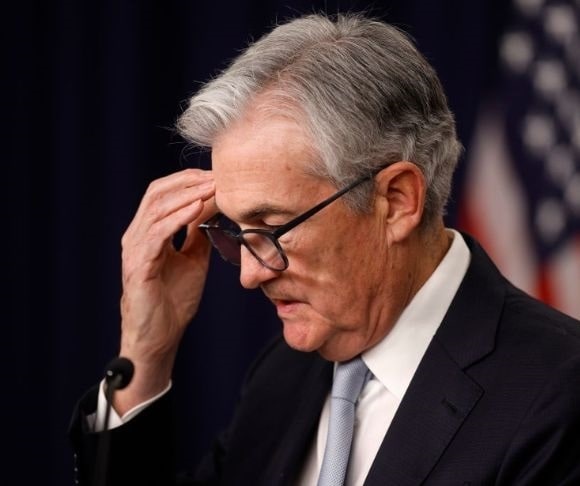Investors experienced every emotion possible during Federal Reserve Chair Jerome Powell’s post-Federal Open Market Committee (FOMC) press conference. At first, the financial markets cheered after observers noticed two words: “cumulative” and “lags,” which suggest an environment of slowing down the pace of rate hikes. But then traders’ moods turned sour within a few minutes as Powell dashed everyone’s hopes of a pause or a pivot. But the head of the world’s most powerful institution understood what he was doing, effectively admitting that he wields power over Wall Street, with everyone trying to execute trades based on what the Eccles Building does. It is safe to say everyone is now more confused than before.
Jerome Powell Laughs at You
 For the fourth consecutive meeting, the central bank pulled the trigger on a 75-basis-point rate hike, lifting the benchmark fed funds rate (FFR) to a target range of 3.75% and 4.00%. The move, which everyone on The Street widely expected, brought the FFR to the highest level since 2008. But it was the post-meeting statement that captured all the attention and buzz.
For the fourth consecutive meeting, the central bank pulled the trigger on a 75-basis-point rate hike, lifting the benchmark fed funds rate (FFR) to a target range of 3.75% and 4.00%. The move, which everyone on The Street widely expected, brought the FFR to the highest level since 2008. But it was the post-meeting statement that captured all the attention and buzz.
“The Fed will take into account the cumulative tightening of monetary policy, the lags with which monetary policy affects economic activity and inflation, and economic and financial developments,” the statement read. “The Committee anticipates that ongoing increases in the target range will be appropriate in order to attain a stance of monetary policy that is sufficiently restrictive to return inflation to 2 percent over time.”
This announcement ignited a rally among the leading benchmark indexes, including the Dow Jones Industrial Average, which surged more than 300 points. The US Treasury market tanked, while the US Dollar Index (DXY) plummeted. Hedge funds, institutional investors, and the cool kids of Robinhood were ebullient. The end was near! A slowdown was on the horizon! “It may come as soon as the next meeting or the one after that,” he said. Well, not so fast.
At the start of the press conference, Powell suggested that a pause was coming, reiterating what the FOMC had stated. However, at about halfway through the powwow with the press, the Fed chairman contended that it would be “premature” to even entertain the idea of slowing down or pausing the central bank’s tightening cycle. “We still have some ways to go,” he said. “And incoming data since our last meeting suggests that the ultimate level of interest rates will be higher than previously expected.”
This was like parents who keep telling their kids they are going to Disney World, only for them to laugh and inform the children they are instead going to Aunt Maude’s house to lick some stamps. For all the policy pivoting talk, these comments were the significant turnaround that investors did not expect.
What About Inflation?
Jerome Powell conceded that the inflation fight is hardly over. He alluded to the higher core personal consumption expenditure (PCE) price index as proof of the inflationary pressures not subsiding at a pace the Fed would like. Financial markets agreed as the futures arena speculated that the effective terminal rate would climb to as high as 4.97% by May 2023. Until then, according to the CME FedWatch Tool, investors are about split on whether the FOMC will agree to a 50- or 75-basis-point hike. It may depend on the upcoming consumer price index (CPI) reading, which is projected to remain unchanged at 8.2%.

Jerome Powell (Photo by Chip Somodevilla/Getty Images)
Despite the talking heads on CNBC and Bloomberg TV discussing if the Fed is overtightening monetary policy, Powell dismissed this suggestion, arguing that the real interest rate is still below the annual inflation rate. In addition, he reiterated the previous argument that there is a real risk of not doing enough and pulling back prematurely rather than doing too much, although Powell does not believe this is the case. In the end, Powell told reporters that the path to a soft landing – economic expansion and a labor market intact – has narrowed. “Policy needs to be more restrictive, and that narrows the path to a soft landing,” Powell stated.
Just Front Load Already
Rate-setting Committee members patted themselves on the back, thanks to the 375-basis-point worth of interest-rate increases since March. But this is not accomplishing its end game of lowering the FFR to the 2% target rate. The annual CPI rate is north of 8%, while the Fed’s preferred PCE price index is around 5%. If the organization wished to rein in rampant price inflation, the central bank would have adopted St. Louis Fed Bank President James Bullard’s recommendation of front-loading rate hikes rather than a campaign of modest movements. Indeed, everybody wants to mirror the policy directives of the 1990s, but the real solution might be to implement the prescription of the 1980s: a double-digit federal funds rate. This would advance the inflationary battle rather than allow entrenched inflation to linger and cause millions of households to suffer from the cost-of-living crisis. Perhaps the guessing game is more fun.




